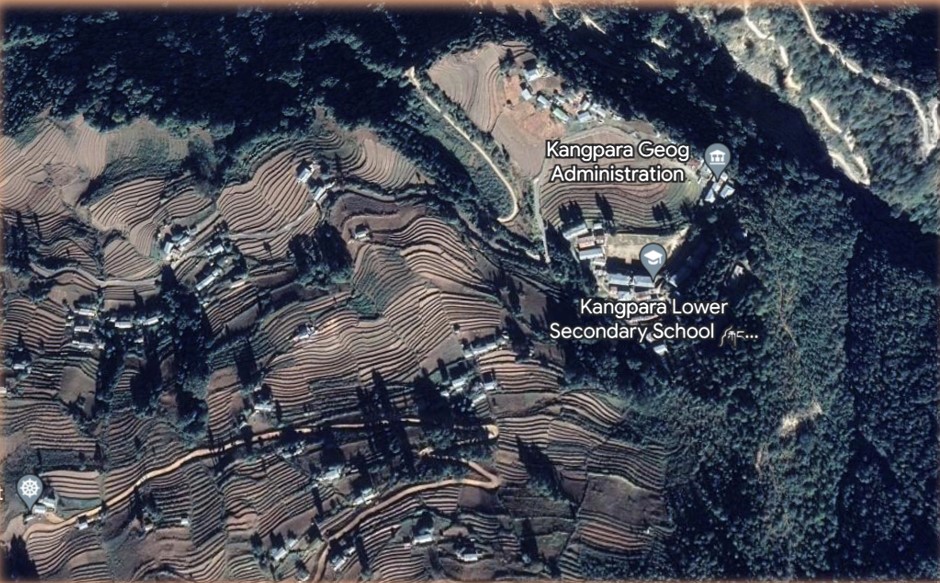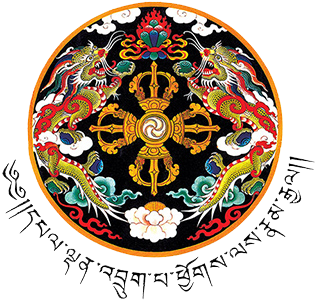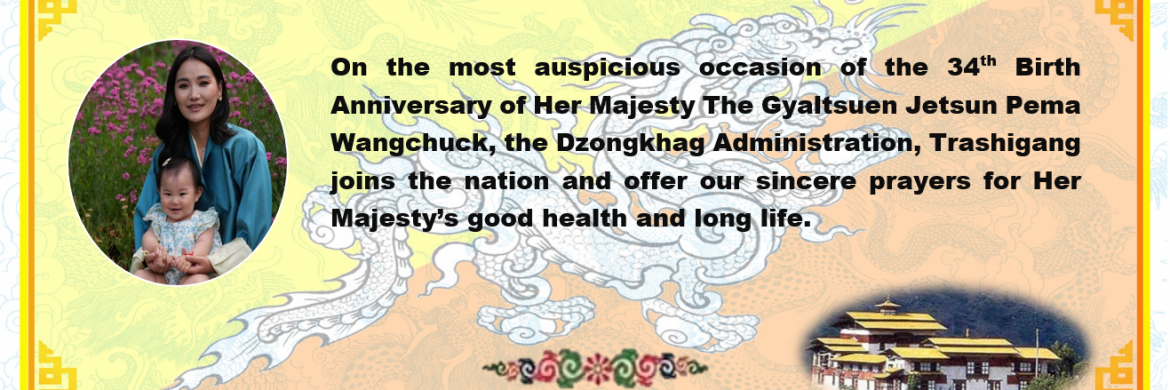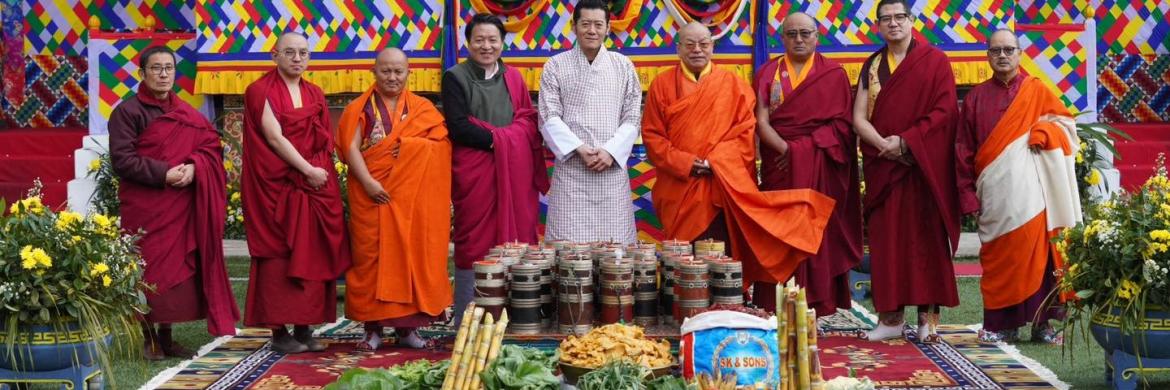
Kangpar Gewog is a gewog (village block) of Trashigang District, Bhutan. Kangpara Gewog, along with Thrimshing Gewog, comprises Thrimshing Dungkhag (sub-district). Kangpara is one of the remotest gewogs under Trashigang Dzongkhag. The kangpar is located at 107 kilometer toward south of Trashigang Town.The gewog is 341.9 square kilometers and shares borders with other gewogs like, Thrimshing, Shongphu, Khaling, Merak gewogs of Trashiagng and Gomdar, Shingkhar Lauri of Samdrup Jongkhar. Kangpara is popular for housing some sacred monasteries like Lamai Goenpa, Sikhar Goenpa and Chenlai Nye et al., and is also popular for their belief in deities like Ama Jomo , Mem Pangzam and Meme Dangling.
The word "Kangpara" literally means "footprint." There are footprints of Lord Buddha in a hermitage. According to oral sources, the footprints were said to be carved by a great lama Drupthob Dong-nga Rinchen. He visited Bodh Gaya and on his return, brought with him imprints of Lord Buddha's footprints. Using them as a model, he carved the footprints on a stone in the hermitage. It is considered by the people as one of the most sacred relics of the lhakhang along with the Drupthob's walking cane.
Kangpara Gewog has a total population of 4590 and has about 497 households. The gewog houses about 18 villages and some of the major villages are Pasaphu, Paydung, Madewa, Kangpara, Kheri, Kheshing, Lamyong, Rebaling, Brumshari, Chorphu, Neyling, Bedingphu, Sarong, Merda, Lagoen Gorenchenma, Zordung and Threlphu.
The Gewog has a temperate climate with warm summers and cold winters. Gewog topography is Gentle to steep sloppy and deep gorges. The settlement is most scattered. The soil is acidic in nature. The highest altitude recorded in the Gewog is 2600 meters approximately and the lowest altitude 1300 metres approximately above sea level. The Gewog has total of 79percent forest coverage and predominated bybroadleaf forest.
The head of the gewog or "gup" is sangay Tenzin and the Gewog Administration Officer is Phuntsho wangmo. The offices in Woongthung, near Kangpara Lower Secondary School. Apart from the gup and Gewog Administration Officer, the gewog like every other gewog has a Magmi and Tshogpas to look after the affairs of the people and actively participate in the democratic process.
The people of the gewog saw unprecedented changes and developments. The electrification and mobile network has cover almost all the villages in the gewog. The accessibility of the mobile means that farmers of the gewog can keep up-to-date with their relatives and alike who stay in different parts of the country, mostly as civil servants. The gewog has 2 schools, namely, Kangpara Lower Secondary School and Zordung primary School. Besides, a farm road connectivity has also connected to all villages. The farm road will prevent people from walking six hours to reach the nearest road and will benefit around 497households of Kangpara.
The people of Kangpara along with the people of Kheng are renowned throughout the country for their unparalleled craftsmanship. The most exquisite handicraft product the artisans produce is called "Bangchung". The raw material used to make handicrafts like Bangchung is called "Ringshu" (Neomicrocalamus and ropogonifolius), which they fetch in bulk from places like Remung, under Orong Gewog, S/Jongkhar. Handicrafts are a major source of income for the people of lower part Kangpara, and they market their finished products to other parts of the country in exchange for hard currency. The connecting of the farm road to the gewog is likely to further ease artisans of the gewog in fetching raw materials and transporting their finished products.
Farmers cultivate crops like chillies, potato, Sweet buckwheat, paddy and maize, of which, chillies and potato are essentially cultivated to earn some cash income and the latter two for domestic consumption. The gewog has also have two furniture shop. They made different wood product from there and sell within country to earn cash income. Also, a relatively small percentage of the population, precisely in the north, are nomads and livestock farming plays a dominant role in their everyday life; for them, livestock and livestock products are the only means where-through they can scrape out a living.
Gewog Profile Kangpar Gewog 2023
Population and land use
Area(Sq. Km) 63.32sq.km
Km from Dzongkhag head Quarter to Gewog center 22km
Population Figure Total 5459
Male 3184
Female 3159
population Dencity ( per Sq Km) 86.2
Administrative units
Gewog Center 1
Chiwogs 5
No of villages 9
No of Gongtong/Khangtong 118
RNR Center
RNR Center 1
Range office 1
Piggery Farm 1
Poultry farm 3
Milk Processing unit 2
Active/ registered Farmers Group 6
No of community forestry 3
No of Farm Road 27
Length of farm Road in Kms 80.355
No of electric fencing 7
length of electric fencing in Kms 4.204km
No functional of Irrigation channel 19
length of functional Irrigation channel 23.76
Health Center
Hospital 1
No of BHU 1 0
No of BHU 11 0
ORC with shade 3
Education
Higher secondary school 1
Middle secondary school 0
Lower secondary school 1
Primary school 3
Extended classroom 0
Non formal education center (NFE) 2
Early Child Development Center(ECCD) 6
Religion and culture
No of community own Lhakhang 4
No of Government Lhakhang 2
No of Private own Lhakhang 4
No of chortens 111
Bridges
Total number of motorable bridge 2
Total number of non-motorable bridge 0
Demography by chewog wise
Sl No Chewog name Male Female Total
1 Bedengphu_merdag 139 98 237
2 Thelphu 47 54 101
3 Zordung 145 166 311
4 Kangpar Lemjong 334 361 695
5 Pasaphu Pedung 107 140 247
All chewog 1591




